JRDG Company Special – Model 2
1994-1999
Retail price in 1998 in the Netherlands 7.940 euro
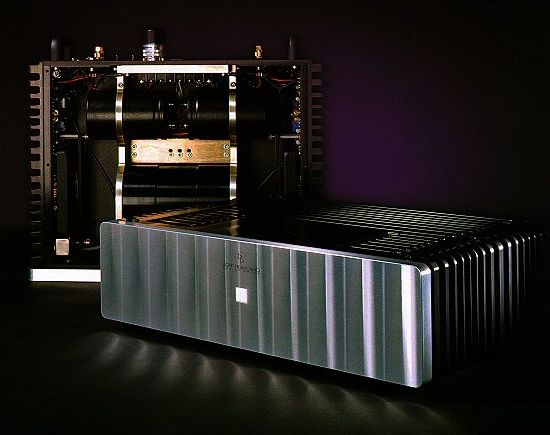
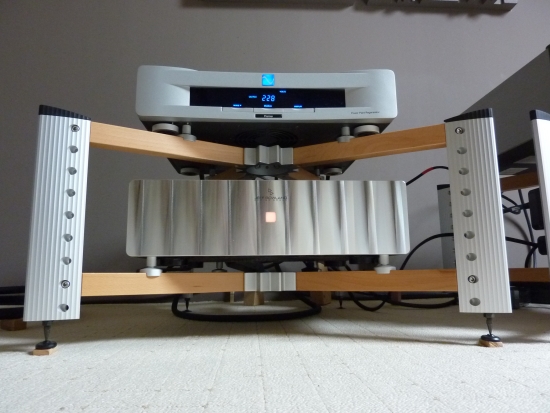
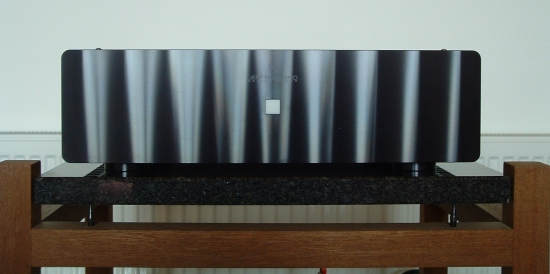
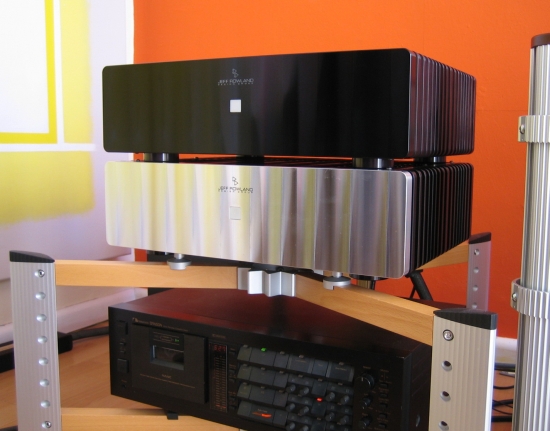
The model 2 (the black one on top) is a more modern design than the model 1. Inside it is highly sophisticated and well-worth using a transparent cover! Fully balanced, efficiently biased highly but not too high using bipolar transistors and with several adjustments possible on the rear this is a very flexible amp. Both technically and audibly it is like a stereo version of the model sixes.
In my opinion one of the best stereo poweramps around. It doesn’t have it’s predecessor’s thickness/warmth but it threads a fine balance between resolution, pace, openness, air, transient speed and attack on the one hand and fluidity, warmth and sheer musicality on the other. This amp is incredibly fast and well-controlled and you might even find it slightly lean in balance, but is it ever so musical! It has the most airy and fluid/continuous treble that I have ever heard. It surpasses even all the tube amps that I heard in my setup so far in this respect while maintaining speed and control and that’s saying something. I compared it directly to the model 6 monos on both B&W Nautilus 804’s and Martin Logan SL3’s and they are sonically very close. You really have to know your system well to be able to tell the differences. The sixes do have some more bass and a wider soundstage. But that’s about it. Sure the sixes also have more power reserve but you don’t notice this unless you start abusing the volume control, or have more demanding speakers.
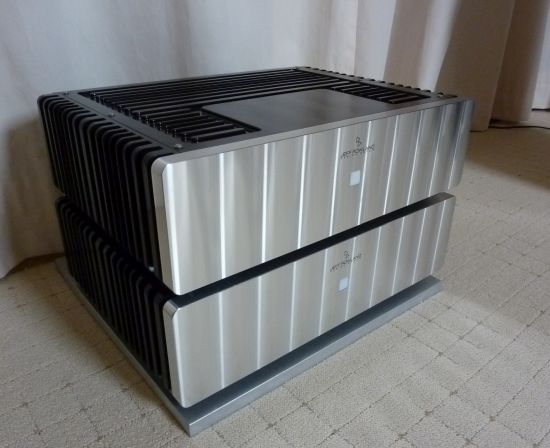
Above: Model 2 + BPS2
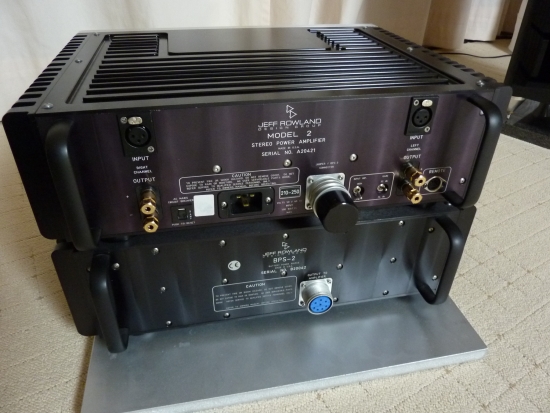
Above: Model 2 + BPS2 rearside (no DC cable connected, and amp socket shorted with cap). Notice the two switches on the rear, near the right hand speaker binding posts? They are for gain and impedance. With these switches you can influence the sound quite a bit. Low impedance makes for less attack and perceived dynamics but is a lot smoother and more fluid in the highs while high gain has again more attack but is also more dry and low gain is more relaxed. These switches are both on the model 2 and model 6 as well as on a lot of other Rowland amps.

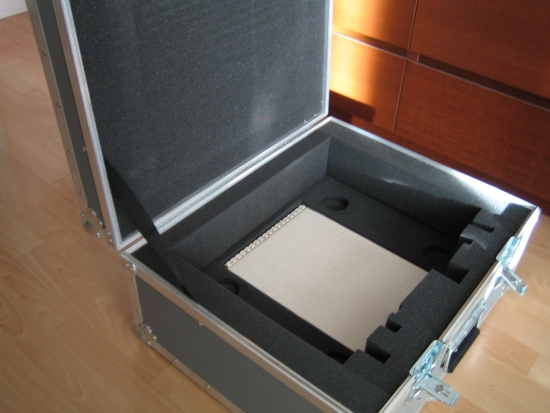
Model 2 flightcase
Inside Pics
The model 2 is very closely related to the model 6. While the latter are mono blocks in which each side handles one phase of the signal to combine into one balanced mono signal per amplifier, the model 2 divides the available 16 transistors over two channels while retaining the balanced topology.
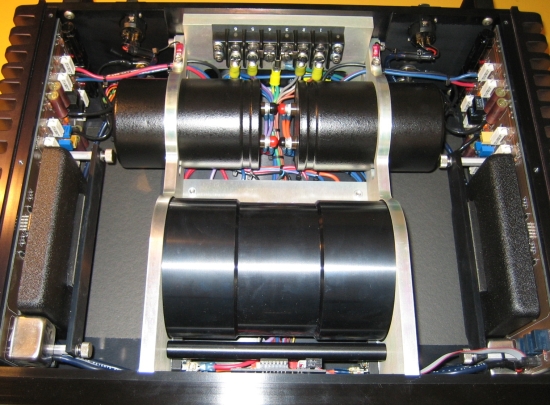
Above: Model 2 top side inside
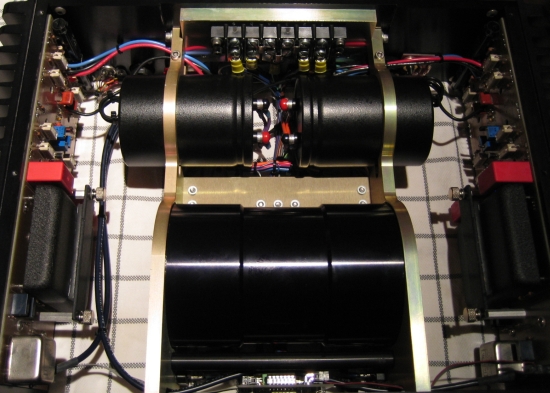
Above: Model 6 mono block top side inside
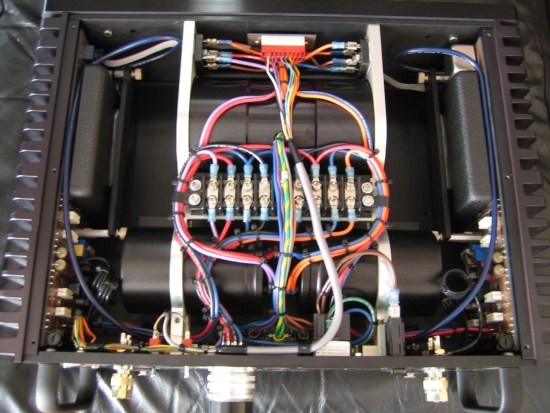
Above: Model 2 underside inside
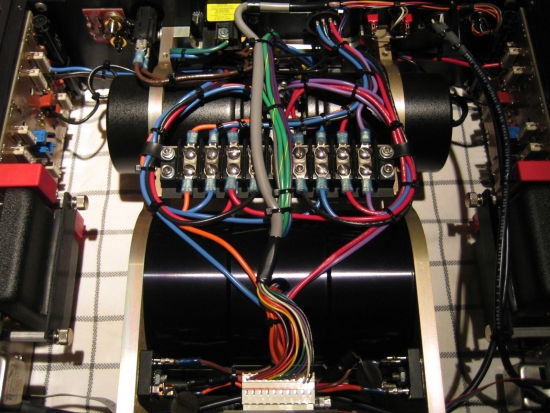
Above: Model 6 monoblock underside inside (front-rear reversed)
Troubleshooting
Model 2 Fuse blown
I’ve had an instance where the fuses in my Model 2 were blown and apparently this has happened to others. The fuses are located in the sidepanel heatsinks, two on the left and two on the right. Just in case that a previous owner has installed different fuses here’s what is supposed to be in there: Fast Blow 5 to 7 amp.
(Optional) BPS unit DC Cable Compatibility
Model 2 Features
XLR Balanced Input jacks for balanced (Differential Mode™) system configurations
XLR to RCA Input adapters included þUser-selectable overall gain of 26 or 32 dB
User-selectable input impedance of 36kΩ(HI) or 600Ω(LO)
All internal signal circuitry is totally isolated from chassis and system ground potentials to eliminate noisy ground loops and to provide extreme immunity from RF interference
Optional remote (wired or wireless power ON/OFF switching)
Automatic temperature stabilizing circuitry maintains constant operating temperature
Standby power condition reduces warm-up time
Fail-safe operation provided by user-resetable AC circuit breaker located on rear panel
Quiet, transient-free operation during power and function mode switching
Automatic input muting under anomalous input or output operating conditions
Balanced Differential Mode™ circuit topology implemented from input to output
Plug-in modules, containing critical electronic circuitry, enhance thermal stability, mechanical integrity and serviceability
Low-resonance, structurally integrated chassis of precision machined aluminum alloy components.
Model 2 Technical Specifications
Output Power Continuous RMS watts
@ 8 ohms 75 watts
@ 4 ohms 150 watts
Power Bandwidth
0.1 Hz to 160 kHz, -3 dB
Slew Rate
80 volts per microsecond
THD and Noise
Less than 0.05% at rated power
Damping Factor
Greater than 100, 20 Hz to 20 kHz, 8 ohms
Output Current
20 amps continuous
35 amps peak
Overall Gain & Sensitivity
User selectable on rear panel (1 watt, 8 ohms)
26 dB or 32 dB; 141 mV or 71 mV
Input Impedance
User selectable on rear panel
Unbalanced 36k or 600 ohms
Balanced 36k or 600 ohms
Common Mode Rejection Ratio
Greater than 60 dB, 20 Hz to 20 kHz
Power Consumption
25 watts standby
175 watts operating, idle;
400 watts maximum
Inputs
User selectable on rear panel
Unbalanced With supplied XLR/RCA adapter
Balanced 2 XLR connectors
Outputs
1 pair binding posts per channel
Dimensions
17.5 in. W x 14.25 in. D x 5.25 in. H 44.5 cm W x 36.2 cm D x 13.3 cm H
Shipping Dimensions
24 in. W x 20 in. D x 12 in. H 61 cm W x 50.8 cm D x 30.5 cm H
Weight
47 lbs. (21.5 kg)
Shipping Weight
75 lbs. (34.0 kg)
BPS (Battery Power Supplies)
More Jeff Rowland
Jeff Rowland Company Special Main Page
Jeff Rowland Company Special Power Amplifiers
Hello Christiaan, do you think Model 2 is nowadays still good purchase, or could it be already a bit burn-out?
I currently own an older Arcam Solo Music v1 with the “famous” LM3886T chips. Plays like a charm.
Almost without exception (model 10) Jeff Rowland Rowland amplifiers have proven to be super reliable and a model 2 still sounds great. But it’s getting old and at some point, it may need a recap or a line stage module replacement. In that case, it is good to know that Jeff still repairs classic models. That said, of course, there are many alternatives although most better amplifiers are also more expensive. A very good amp with some of the model 2 characteristics for less money than a second-hand model 2 would be the NuPrime AMG-STA. Also please note that just using the LM3886 chip doesn’t create the JRDG sound.
Hallo beste lezers,Christiaan
Bij mijn M2 zijn de rubberen schijfjes voor onder de versterker versleten en aangezien de spikes in mijn situatie niet goed klinken ben ik op zoek naar alternatieven.
Ik heb het volgende al geprobeerd:Sorbothane, natuurrubber 40shore,foculpods,epdm rubber 65shore maar niets klinkt zo goed als de originele pads.
Wie heeft hier ervaring mee?
Vriendelijke groet,
Rik
Hi Rik, Misschien heb ik ze steeds gemist maar zover ik weet werden er geen rubber schijfjes bijgeleverd. Ik heb ze iig nooit gehad of gezien en een vriend die destijds nieuwe zessen kocht, had ze ook niet. Wel grote cones/spikes, die in de uitsparingen van de voeten passen. Ik gebruikte de M2 en M6 altijd rechtstreeks met hun metalen poten op de ondergrond.
Hoi Christiaan,
Misschien voor de lezers interessant ik gebruik nu al een tijd 2x MLytic-HC 47.000uf 80v van Mundorf in mijn M2.
In de M2 zijn ze origineel 2x 39.000uf 50V of 63V.(JR)
De Mundorfs passen weliswaar niet in de gaten maar het past er wel net tussen met wat passen en meten.voor de gaten heb ik trespa schijfjes laten zagen en die in de openingen geklemd en daar tegen aan de mundorf caps met plastic isoleer doppen over de boutjes.
Ik zie dat ik niet gereageerd heb op jouw antwoord van een jaar geleden mijn excuus hiervoor, het is vreemd dat jullie er geen sorbothane schijfjes bij hebben gehad ik zag onlangs op Ebay een M2 daar zaten ze ook bij.
Ik heb de originele spikes en die creëren wel een veel preciezer en gedetailleerder beeld maar blijf het in het toch kaler vinden klinken mis wat body maar dat kan ook liggen aan dat de voeding niet gescheiden is zoals bij de M6 (ik heb Magnepan 3.7)
Vriendelijke groet,
Rik
Hi Rik, thanks for the info. The JRDG Spikes are very pointy and indeed create a slender, tight, and comparatively dry sound. Owners often keep certain accessories when selling items, I really cannot recall the details, but guess the same happened with these discs when I purchased my model 2. In any case, I’ve never liked the sorbothane discs with the power amplifiers. With the preamplifiers, I find they work quite well, but they do reduce the speed and PRaT. Of course, this is also system-dependent. Between Model 2 and Model 6, there is not as much difference as one might assume. They also have very similar power supplies. The separate chassis with the Model 6 were the BPS6 battery power supplies. These add body and fulness to the sound, but at the cost of a bit of control and attack.
Bedankt voor je info Christiaan.
Leuk trouwens jouw youtube filmpjes!
Groet
Rik
Thanks!